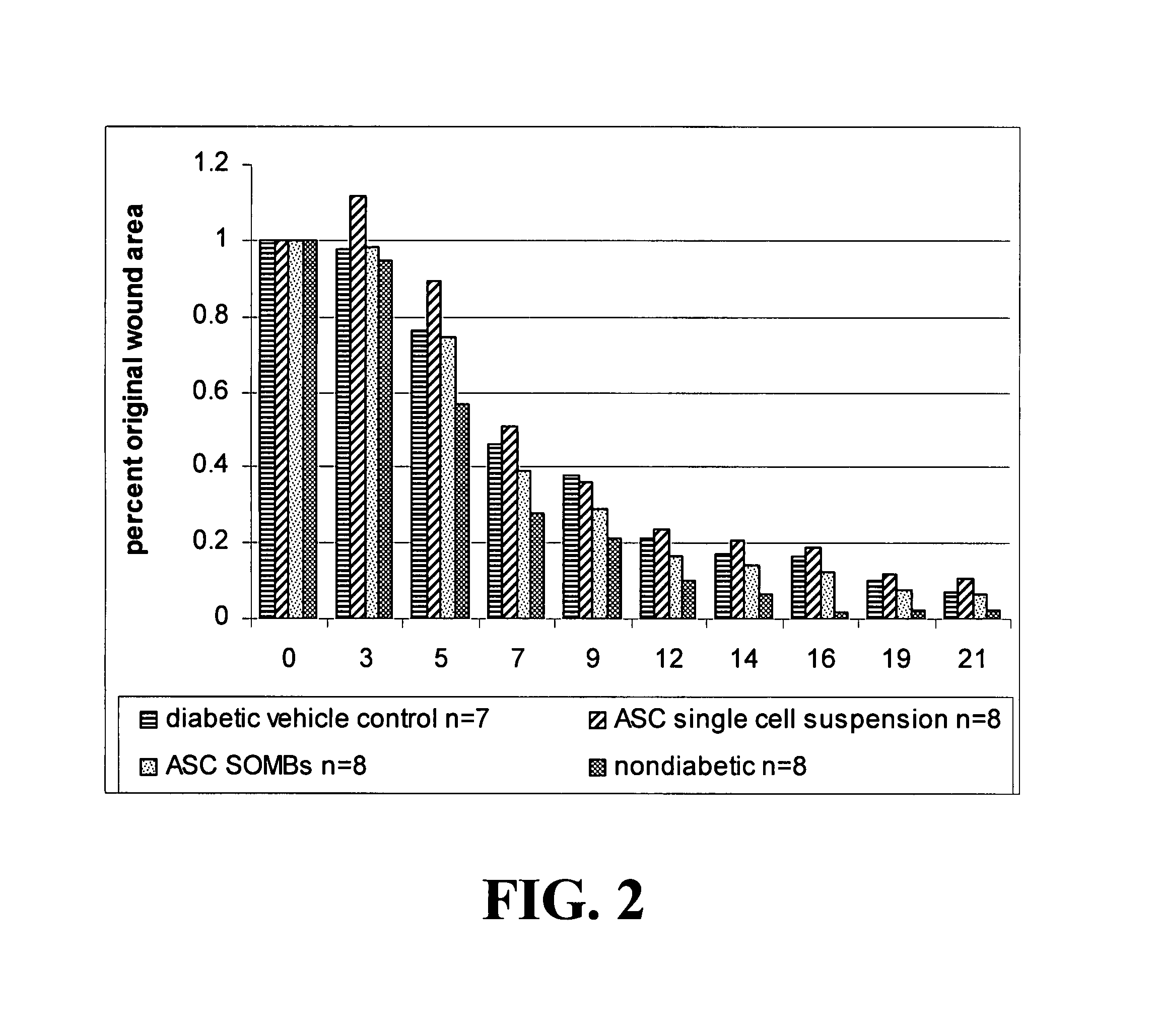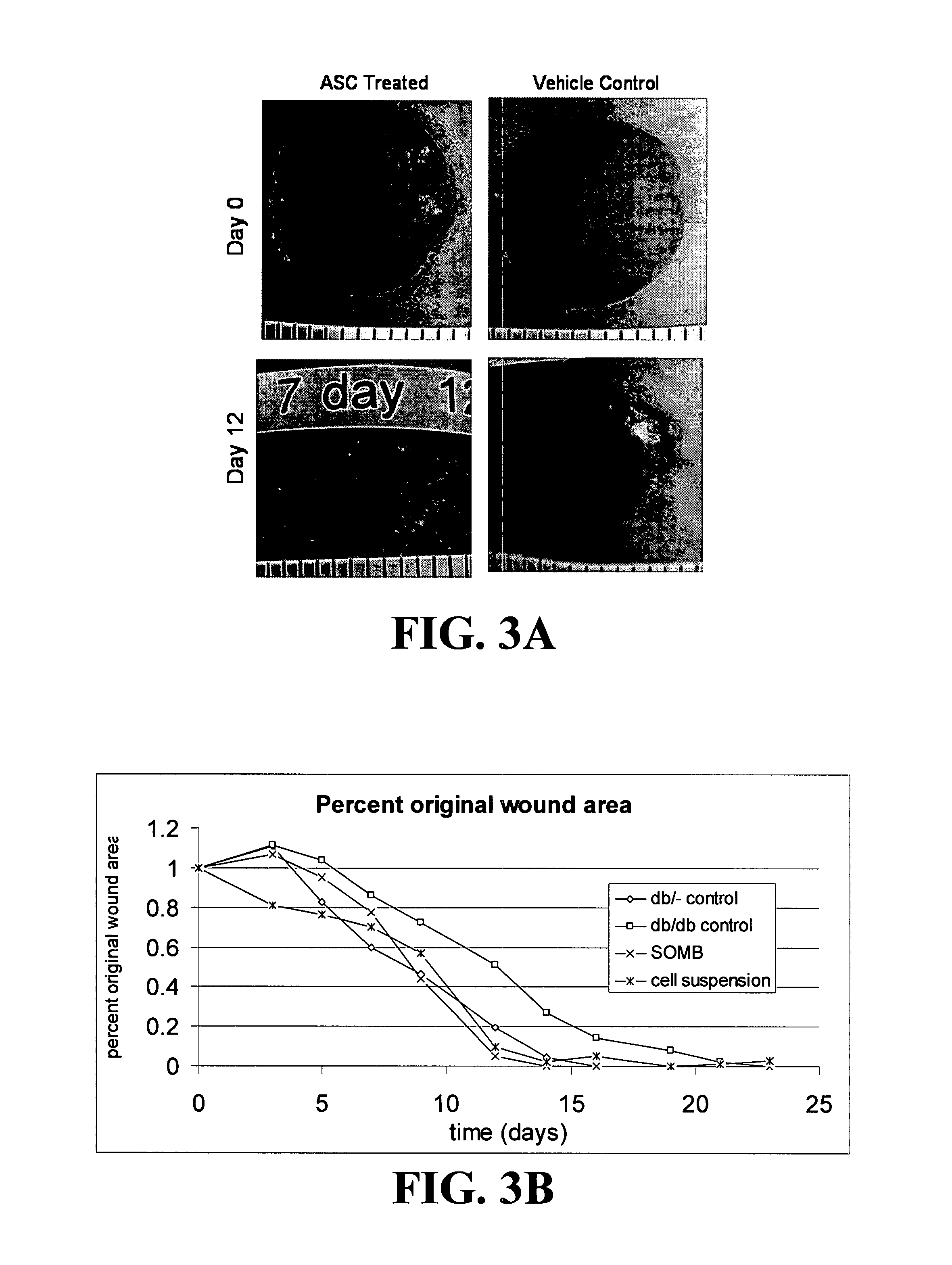Methods and compositions useful for diabetic wound healing
a technology for wound healing and compositions, applied in drug compositions, peptide/protein ingredients, metabolic disorders, etc., can solve the problems of difficult and costly process for obtaining and isolating such cells, and the use of such cells is hampered by several technical hurdles
- Summary
- Abstract
- Description
- Claims
- Application Information
AI Technical Summary
Problems solved by technology
Method used
Image
Examples
embodiments
[0148]The present application is based on the finding disclosed herein that adipose tissue-derived cells are useful in treating wounds, i.e., enhancing the healing of wounds.
[0149]The cells of the invention provide advantages such as translatability, reproducibility, and predictability in their use. Additional advantageous characteristics of the cells and methods of the invention include:
[0150]ability to culture / manufacture in defined, serum-free conditions, with no foreign proteins (i.e., no FBS);
[0151]enhanced production of growth factors compared to monolayer cultured cells;
[0152]self-generated matrix, no need for bovine collagen or other xenogeneic ECM components;
[0153]immediately implantable, with no need to trypsinize;
[0154]extensive replicative capacity;
[0155]less variability, more predictable biology than cells grown as monolayer cultures;
[0156]robust (hypoxia; anoikis), able to survive implantation in vivo better;
[0157]dynamic (respond to environment); and
[0158]amenable to ...
example 1
General Methods
[0254]The adipose tissue-derived stromal cells useful in the methods of invention are isolated by a variety of methods known to those of ordinary skill in the art. A preferred source of adipose tissue is subcutaneous adipose. In humans, the adipose is typically isolated by liposuction.
[0255]Human adipose tissue-derived adult stromal cells represent a stem cell source that can be harvested routinely with minimal risk or discomfort to the patient. They can be expanded ex vivo, differentiated along unique lineage pathways, genetically engineered, and re-introduced into individuals as either autologous or allogeneic transplantation.
[0256]Methods for the isolation, expansion, and differentiation of human adipose tissue-derived cells have been reported. See for example, Burris et al 1999, Mol Endocrinol 13:410-7; Erickson et al 2002, Biochem Biophys Res Commun. Jan. 18, 2002; 290(2):763-9; Gronthos et al 2001, Journal of Cellular Physiology, 189:54-63; Halvorsen et al 2001,...
example 2
Production of Growth Factors by SOMBs (SNiMs)
[0279]Materials and Methods:
[0280]Growth Factor Studies:
[0281]To determine whether ASC-SOM-Bs (SNiMs) produce growth factors when maintained in suspension culture, freshly isolated ASCs were grown to confluence in adherent monolayer culture in D10 medium. The cells were lifted into suspension and depleted of CD31+ and CD45+ cells using MACS columns (Miltenyi Biotech Cat #130-042-201) and anti-CD 31PE and anti-CD 45PE antibodies (BD Bioscience) and anti-PE microbeads (Miltenyi Biotech, #130-048-801). The passage 1 (P1) CD31− / CD45− ASCs were then plated into monolayer culture at 2000 cells / cm2 in D10 medium. At confluence, the cells were again lifted into suspension and an aliquot was used for immuno-characterization using flow cytometry (see below). Of the remaining cells, half were used to create 20,000 cell SOM-Bs (SNiMs), and the other half were kept in monolayer culture. After 24-48 hours in hanging drop, individual SOM-Bs (SNiMs) were...
PUM
| Property | Measurement | Unit |
|---|---|---|
| pH | aaaaa | aaaaa |
| mole fraction | aaaaa | aaaaa |
| mole fraction | aaaaa | aaaaa |
Abstract
Description
Claims
Application Information
 Login to View More
Login to View More - R&D
- Intellectual Property
- Life Sciences
- Materials
- Tech Scout
- Unparalleled Data Quality
- Higher Quality Content
- 60% Fewer Hallucinations
Browse by: Latest US Patents, China's latest patents, Technical Efficacy Thesaurus, Application Domain, Technology Topic, Popular Technical Reports.
© 2025 PatSnap. All rights reserved.Legal|Privacy policy|Modern Slavery Act Transparency Statement|Sitemap|About US| Contact US: help@patsnap.com



